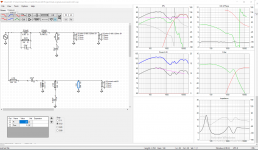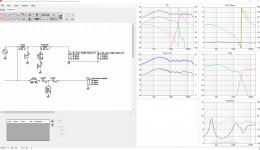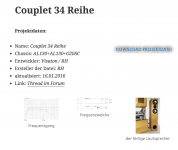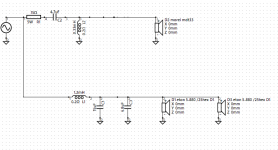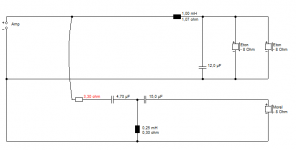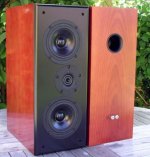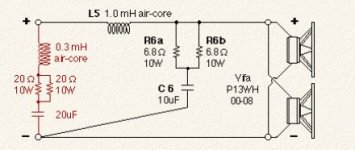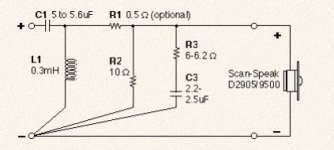The results you got there were so bad, that I think there is something you are doing wrong here. The second one is not too bad, the first one is just a mess because you haven't adjusted it for your particular woofer.
I looked up the Eton 5", which is a fairly well behaved 6 ohm driver with highish inductance and a bit of natural rolloff.
https://lautsprechershop.de/pdf/eton/eton_5_880_25hex.pdf
The Morel tweeter is just a regular sort of 6 ohm thing and needs no special attention.
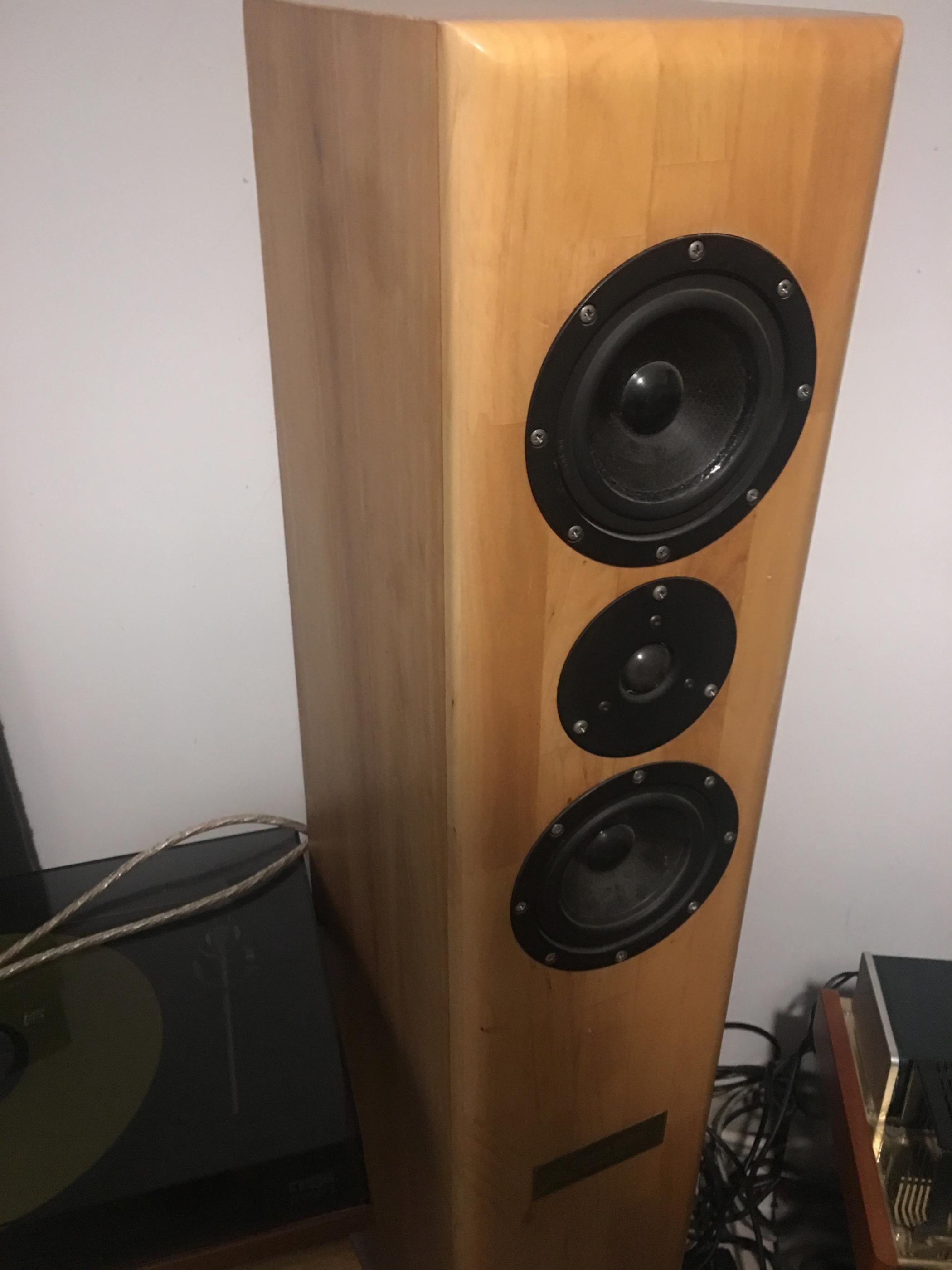
You said this is a custom design. Nothing wrong with it physically. I presume you have done something sensible with the bass loading. It's a reflex driver, QTs 0.4. Is it your filter?
You really shouldn't need anything beyond second order on the 5" bass and a crossover around 3kHz.
Since your modelling in vituixCAD is going so wrong, and I dislike that program as being unintuitive, maybe you should abandon it. Boxsim might give you a better time:
Software | Visaton
Boxsim Projektdatenbank
Import these bpj files for a quick start. Just find a similar project and import FRD and ZMA files.
I looked up the Eton 5", which is a fairly well behaved 6 ohm driver with highish inductance and a bit of natural rolloff.
https://lautsprechershop.de/pdf/eton/eton_5_880_25hex.pdf
The Morel tweeter is just a regular sort of 6 ohm thing and needs no special attention.
You said this is a custom design. Nothing wrong with it physically. I presume you have done something sensible with the bass loading. It's a reflex driver, QTs 0.4. Is it your filter?
You really shouldn't need anything beyond second order on the 5" bass and a crossover around 3kHz.
Since your modelling in vituixCAD is going so wrong, and I dislike that program as being unintuitive, maybe you should abandon it. Boxsim might give you a better time:
Software | Visaton
Boxsim Projektdatenbank
Import these bpj files for a quick start. Just find a similar project and import FRD and ZMA files.
Last edited:
Since your modelling in vituixCAD is going so wrong, and I dislike that program as being unintuitive, maybe you should abandon it.
I would abandon you from this site.
You want to talk about speakers or me?I would abandon you from this site.
Your idea didn't look bad, but has been hopelessly badly implemented with that resistor on the bass, as you mentioned:
I'll leave you on first base to fix this mess. I'm out.
^That's is version 1.1. I really hope that you study version 2, whole program package and it's philosophical targets before advising anybody to abandon it to something obviously worse. I realize that beginners are very difficult students because they may know close to nothing about acoustics, electricity and speaker drivers. This kind of discussions might still be quite entertaining.
You want to talk about speakers or me?
Your idea didn't look bad, but has been hopelessly badly implemented with that resistor on the bass, as you mentioned:
I'll leave you on first base to fix this mess. I'm out.
I really don't understand why are you spinning the story. What's your stake in this ?
Kimmosto didn't recommend series resistor on the midwoofer. Quite the opposite, he tried to convince Hubi to get rid of it.
I'm starting to feel like i'm on some sort of crusade here because i've said it more than once, but i'll say it again - VituixCAD is the most complete loudspeaker designing software available for free. It is second to none regarding performance. No, it doesn't have an icon for every little thing one would imagine to do. None of the serious software does that. Feed it the right set of measurements and the resolution of what one is doing goes sky high. From 2010 i've used Passive Crossover Designer 7 by Jeff Bagby, WinPCD, Boxsim, LspCAD and recently VituixCAD. Transferring to VituixCAD from any of those is like going to Full HD TV from SDTV.
Last edited:
Listen guys thanks to everyone - all of you helped me!
I managed something from what I learned I maked it only from my hearing without any softwares and its sounds grate much better from the original crossover!
thanks again to everyone!
My next step will be buying a microphone frequency measurement
and start again.
I managed something from what I learned I maked it only from my hearing without any softwares and its sounds grate much better from the original crossover!
thanks again to everyone!
My next step will be buying a microphone frequency measurement
and start again.
Attachments
I have to agree with Zvu, vituixcad is by far the best speaker design software I've used so far. It doesn't do everything I want but it is damn close. The one thing that I go elsewhere for (speaker workshop) is putting multiple curves onto one graph so that I can compare them.
I didn't like the crossover modeling in version 1.1 but lucky for me version 2 came out within a week of me trying version one and I like it a lot!
I've used PCD7, boxsim, xsim, and speakerworkshop and I think Vituixcad 2 was by far the quickest to get up to speed on.
Tony.
I didn't like the crossover modeling in version 1.1 but lucky for me version 2 came out within a week of me trying version one and I like it a lot!
I've used PCD7, boxsim, xsim, and speakerworkshop and I think Vituixcad 2 was by far the quickest to get up to speed on.
Tony.
Simulation with traced SPL and Z curves and simulated box, LF impedance and directivity. This method is possible with VCAD but it's as difficult as with proper measurements. Looks nice but reliability with traced responses and simplified simulations might be low without luck. Not for manufacturing.
An externally hosted image should be here but it was not working when we last tested it.
OT:
Overlays of Calculator tool enables that too (with Scale, Delay, Invert -function which does nothing by default).
The one thing that I go elsewhere for (speaker workshop) is putting multiple curves onto one graph so that I can compare them.
Overlays of Calculator tool enables that too (with Scale, Delay, Invert -function which does nothing by default).
Last edited:
^Plotting of selected curve in response list A requires clicking of 'Scale, Delay, Invert' radio button and then overlay + button i.e. this is not the fastest tool for comparing multiple responses. Fortunately Calculator is not needed for this while designing speaker because charts in the main program have adequate (1) overlay for reference scenario. That does not encourage focusing excessively to some detail e.g. axial response.
I feel like I have let you down here, hubi. Usually, when a thread turns personal, I just get out. But you don't seem to be getting much help here.
Let's have a review and see if we can altogether skip any need for complex softwares and microphones.

5" plus 1" tweeter. The easiest speaker in the repertoire. Why? No real time-alignment problems. Plenty of overlap between the drivers. Good dispersion from the 5" midbass. A 5" doesn't hit breakup until above 6kHz. Don't worry about any exotic theory about MTM lobing and combing, it works pretty well anyway.
Firstly I suggested looking at a similar project by expert Troels Gravesen, who has built more speakers than most people have had hot dinners. We do not need to reinvent the wheel here:
Vifa PL14WJ-
All I see needs doing to his crossover is adjust the tweeter section to a 6 ohm tweeter. The woofers are very similar to yours, so need no attention. 1mH and 12uF it is for the bass section.
A simple idea with speakers is that once the bass section is fixed, the tweeter section just follows directly. Simple function of a complex variable:
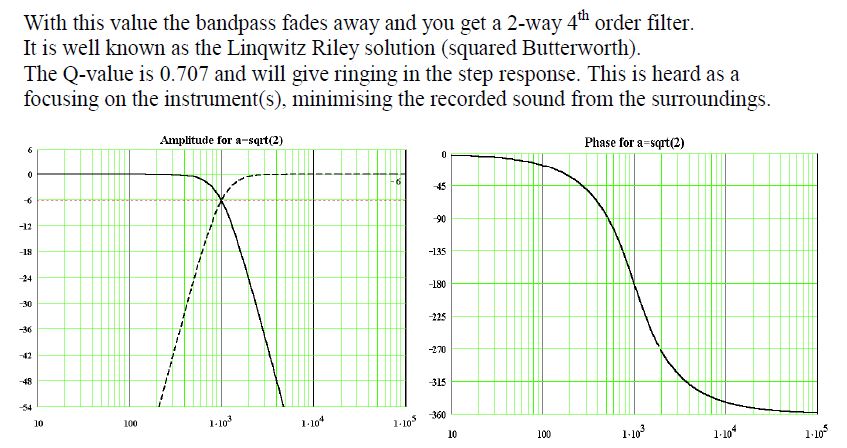
So with electrical 12dB/octave at 3kHz on the bass, we just want the same on the 6 ohm tweeter. I've done that before. I've skipped some little extras which, IMO, help the smooth sound, like attenuators and Zobels after the tweeter filter. To keep it simple. All you do is adjust tweeter level to taste. It ends up quite well phase aligned. Below.
Second below is Troels' MTM speaker. Offset tweeter because the diffraction problems can be awkward, but, TBH, you get what you get and it all averages out anyway. Troels, like me, tends to higher 3kHz crossover. Maybe that is a matter of taste, maybe we think tweeters sound better at higher crossover.
So what was hard about that?
Let's have a review and see if we can altogether skip any need for complex softwares and microphones.
5" plus 1" tweeter. The easiest speaker in the repertoire. Why? No real time-alignment problems. Plenty of overlap between the drivers. Good dispersion from the 5" midbass. A 5" doesn't hit breakup until above 6kHz. Don't worry about any exotic theory about MTM lobing and combing, it works pretty well anyway.
Firstly I suggested looking at a similar project by expert Troels Gravesen, who has built more speakers than most people have had hot dinners. We do not need to reinvent the wheel here:
Vifa PL14WJ-
All I see needs doing to his crossover is adjust the tweeter section to a 6 ohm tweeter. The woofers are very similar to yours, so need no attention. 1mH and 12uF it is for the bass section.
A simple idea with speakers is that once the bass section is fixed, the tweeter section just follows directly. Simple function of a complex variable:
So with electrical 12dB/octave at 3kHz on the bass, we just want the same on the 6 ohm tweeter. I've done that before. I've skipped some little extras which, IMO, help the smooth sound, like attenuators and Zobels after the tweeter filter. To keep it simple. All you do is adjust tweeter level to taste. It ends up quite well phase aligned. Below.
Second below is Troels' MTM speaker. Offset tweeter because the diffraction problems can be awkward, but, TBH, you get what you get and it all averages out anyway. Troels, like me, tends to higher 3kHz crossover. Maybe that is a matter of taste, maybe we think tweeters sound better at higher crossover.
So what was hard about that?
Attachments
But you don't seem to be getting much help here.
Is that so. I've published proper simulation with all available data without peeking design or ideas from anybody. You came as a savior with close to same connection and component values. It's not really difficult for us to clone & modify some known design or make everything from zero with inadequate/inaccurate data. But that does not meet my tolerances, and therefore I cannot honestly recommend it for anybody.
I find nothing wrong with looking at what other people have found works well. Mostly public domain. Even Newton said that if he saw further than most, it was only because he stood on the shoulders of giants. In his case, Copernicus and Galileo I suppose.
What you have done with your bass filter is actually pretty much what Lynn Olson did in the Ariel II MTM with those tidy old 5" Vifa P13WH polycones.
Lynn tuned the Ariel by ear with pink noise to arrive at the near Zobel on the bass, and 6dB electrical I suppose. I don't find his second order tweeter models particularly well, but Lynn likes even order filters as sounding musical. So who knows?
Seems like these Eton drivers are rather good and flat. Much easier than, say, the SEAS ER15RLY. Certainly worth a go.
What you have done with your bass filter is actually pretty much what Lynn Olson did in the Ariel II MTM with those tidy old 5" Vifa P13WH polycones.
Lynn tuned the Ariel by ear with pink noise to arrive at the near Zobel on the bass, and 6dB electrical I suppose. I don't find his second order tweeter models particularly well, but Lynn likes even order filters as sounding musical. So who knows?
Seems like these Eton drivers are rather good and flat. Much easier than, say, the SEAS ER15RLY. Certainly worth a go.
Attachments
Some sanity check might be valuable even for experienced gurus, but my policy and target has been for years that almost anybody could produce reference designs with good methods and tools (such as ARTA, calibrated single channel meas. gear, VituixCAD and recommended design method), knowledge about acoustics and electric circuits and experience with correlation of sound and measurements/simulations. After few projects we have possibilities to evaluate why Olson or Gravesen finally ended up to certain crossover topology and values. Good tools and methods (much better than yesterday's gurus ever had) also means that we don't have to refer or clone designs from the others. Just do what ever we're interested in. But this may take some time due to conservatism, getting stuck in old-fashioned and limited methods and tools.
- Status
- This old topic is closed. If you want to reopen this topic, contact a moderator using the "Report Post" button.
- Home
- Loudspeakers
- Multi-Way
- Crossover advice
